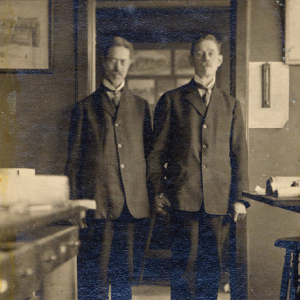Magazine

The Pond Brothers and Democratic Architecture
by Terrence J. McDonald, Director
The opening of the beautifully renovated Michigan Union in January of this year brings to mind the remarkable lives of its original architects, Irving K. and Allen B. Pond. They were principals in the important Chicago architectural firm Pond & Pond, and they designed the Michigan Union, the Michigan League, and the Student Publications Building.
The story of the Pond brothers is a remarkably Michigan one. The Bentley is pleased to hold the Pond Family papers and to have prepared an exhibit on the architecture of the Union and League and the lives of these two men that can be viewed here: myumi.ch/nbekZ
Irving and Allen were both born in Ann Arbor in 1857 and 1858, respectively. Their father, Elihu Pond, was the owner of the Ann Arbor Argus and a committed abolitionist. Their mother, Mary, had met their father while both were students at Albion College. The boys grew up in houses on Fifth Avenue and at State and Huron, and their last family home was actually on the lot that later became the Michigan Union itself. They both graduated from the University, Irving in Civil Engineering in 1879, Allen with a Bachelor of Arts in 1880. Irving, the athletic one, scored the first touchdown in University football history.
A University of Michigan connection helped Irving land his first architectural job in Chicago in 1879. Allen joined him, and they struck out on their own as Pond and Pond, Architects in 1886. They were also unmarried roommates, living together until Allen’s death in 1929.
The brothers plunged into the intellectual and civic life of Chicago and became committed social reformers.
Allen was one of the first Chicago allies of the famous social reformer Jane Addams, who founded Hull House, one of the first “settlement houses” in America, in 1889. Settlement houses were designed to bridge the yawning gaps between Americans in those “Gilded Age” days based on class and ethnicity. Their goal was to welcome, host, and help anyone who came to their front door.

Irving Pond (right) and Allen B. Pond (left) in their office in an undated photo. HS5860
The Ponds volunteered to be the architects for the original Hull House and designed every building at the rapidly expanding settlement thereafter. On the strength of that, they became the architects for other famous settlement houses in the city, including Chicago Commons and the Northwestern University Settlement House, both of which opened in 1901.
What they learned through these designs was what Allen would call a “democratic architecture,” that would preserve old forms, meet new needs, but, most importantly, serve the public good by being welcoming gathering places. It was this attitude that led to their commissions for the Union and League in Ann Arbor and, later, to work designing the student unions at Purdue, Michigan State, and the University of Kansas.
The problem at U-M was that the Michigan Union and Michigan League were single-sex organizations before they were buildings, and so these democratic architects were put to work designing sex-segregated buildings that actually defied their own principles.
In particular, women alive today remember the humiliation of being unable to enter the front door of the Union.
The renovated Union today is open to all, full of the history of the University of Michigan, and thronged with students of all genders and all backgrounds, day and night.
Ironically, the Union better fulfills the hopes of these remarkable men today than it did when they designed it.
